BIG JOY THEMES
building community. making connections. sparking creativity.
Click on a word to see more about that theme.
BIG JOY THEME: POETRY
 It’s obvious really. James Broughton was a prolific poet. He has 21 poetry books to prove it. But more than that he loved words. He didn’t just jot words down on the page and call it good, he fine tuned and refined, until he found the word that held the perfect essence of what he most wanted to convey. He was a wordsmith and a grammarian. He would often start in his journal, and work with a piece until it had just exactly the right words and melody that he was trying to convey. He viewed poetry as song and rhythm; you can see that from many of his poems. Sometimes we break his poetry down into categories (like this “8 Kinds of Poetic Exuberance by James Broughton”). But the truth about poetry and James Broughton is that it was embedded in his life and way of being.
It’s obvious really. James Broughton was a prolific poet. He has 21 poetry books to prove it. But more than that he loved words. He didn’t just jot words down on the page and call it good, he fine tuned and refined, until he found the word that held the perfect essence of what he most wanted to convey. He was a wordsmith and a grammarian. He would often start in his journal, and work with a piece until it had just exactly the right words and melody that he was trying to convey. He viewed poetry as song and rhythm; you can see that from many of his poems. Sometimes we break his poetry down into categories (like this “8 Kinds of Poetic Exuberance by James Broughton”). But the truth about poetry and James Broughton is that it was embedded in his life and way of being.
“A poet has to allow everything to happen to him. Or he can make nothing happen for others. A poet has to let go in order to hold on. Poetry, like love and religion, is a glorious conjunction of sense and nonsense. Without joy there is no wonder. Without wonder there is no magic. And without magic there is no poem,” said Broughton.
He declared that being a poet was one of the first things he knew and understood about himself, even at a very early age. And he once said, “Writing poems keeps me in better spirits than anything else.”
He also said, “It is more important to live poetically than to be a good poet.”
Broughton poetry anthologies: Packing Up For Paradise, Special Deliveries
You can read some samples of his poetry here.
You can peruse all of his books (mostly poetry) here.
You can see his words coupled with images on our Pinterest Page.
Watch our six minute video on James’ poetry.
Click on a word to see more about that theme.
BIG JOY THEME: FILMMAKING
James Broughton is considered by many to be the Father of West Coast Experimental Filmmaking. He was among the first to merge the arts of filmmaking and poetry and also to bring full frontal nudity to the screen. He received the American Film Institute’s Lifetime Achievement Award in Experimental Filmmaking. He wrote a textbook on filmmaking (Seeing The Light / Making Light of It), and taught it at both San Francisco Art Institute and San Francisco State. He has 23 different films that range from quirky to sensual.
He once said that discovering filmmaking in his 30’s “saved me from suicide.” At a time when most, if not all, movies were made only in Hollywood, James was co-creating, experimenting with his artist friends and making his own films. Today he is a prominent name in avant-garde film.
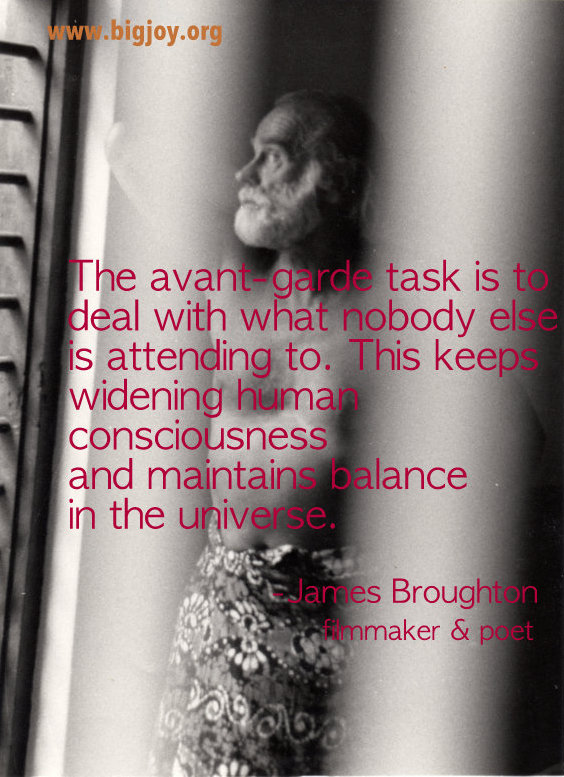 He said, “The avant-garde task is to deal with what nobody else is attending to. This keeps widening human consciousness and maintains balance in the universe.”
He said, “The avant-garde task is to deal with what nobody else is attending to. This keeps widening human consciousness and maintains balance in the universe.”
He also said, “A film is never finished, it is only abandoned. But if we are wise we are not expecting perfection anyway, since nothing in life is perfect, art included. All we alchemists can hope for: to arrive somewhere close to our original vision. Or, at some more astonishing place than we imagined.”
Broughton works especially highlighting this theme: Seeing the Light (downloadable here), and the later revised Making Light of It.
You can see more about his films here.
You can filmmaking quotes on our Pinterest Page.
You can buy a compendium of his films in our store.
Take a look at our two minute video on James’ experimental filmmaking
Click on a word to see more about that theme.
BIG JOY THEME: LOVE
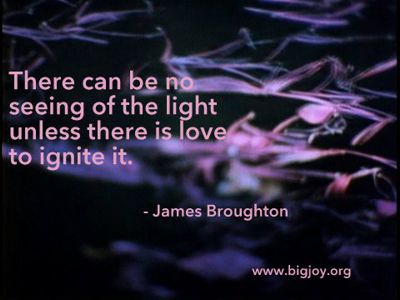 “If ours was a world of love, [James] would be one of its saints. Since it isn’t, he is the exuberant voice in the wilderness, gently yet firmly showing us ‘the way.’” wrote film critic and author, Amos Vogel.
“If ours was a world of love, [James] would be one of its saints. Since it isn’t, he is the exuberant voice in the wilderness, gently yet firmly showing us ‘the way.’” wrote film critic and author, Amos Vogel.
James’ poetry and film is rife with the idea, the experience, and the exploration of love. He wiggles it into nooks and crannies even when you’re not expecting it. He says things like, “There can be no seeing the light unless there is love to ignite it.” and “Love is the ultimate Light… Why not devote your life to being so in love? Can you think of a more absorbing way to use your time?”
James Broughton’s story, told in our film BIG JOY, is a love story. It’s a story of how a man can find his soulmate at the age of 61 (or any age) and how one can make the changes necessary (even when they are extreme, as they were in Broughton’s case) and go on to live the rest of a lifetime in a relationship imbued with joyous love.
James Broughton and his soulmate/husband/creative partner, Joel Singer had a deeply passionate and devotional love that lasted from the moment they first united until James’ death, 26 years later.
Author Armistead Maupin said of the two, “James and Joel had the most beautiful relationship I’d ever seen.”
James has a whole book of poems, Ecstasies, which he wrote for Joel Singer, almost entirely devoted to love. Poet Edward Field says, “[The] love poems he wrote for Joel are the greatest love poems of the era, and for those alone he should be famous.”
James wrote of Ecstasies, “This book is the chronicle of an overwhelming passion and the transformations it inspired. It is a collection of physical and metaphysical love songs to the beloved, the world, and to the visions of a man’s future. It is an alleluia to the surprises and the sublimities of sexual love, offered with praise and joy,”
James Broughton’s work and life was imbued with love. He lived and wrote about the kind of timeless, soulful, and even practically satisfying love that most, if not all, aspire to experience. The kind that makes you want to either lay on a bed and read aloud to your beloved (regardless of your sexual orientation) some of James’ poems, or dream about experiencing it for yourself. Ones like this:
Twin Flames
Embers of night flare up afresh
when you ignite the morning in my arms
and kindle the familiar hearth of love
Year after year we have warmed our lives
around the mystery of mutual fire
that heats our domain of risk and rapture
Whenever scorched however scarred
we hearten heal reconflagrate
Twin flames ever in blissful blaze
Broughton works especially highlighting this theme: Ecstasies
Check out this video Joel Singer made for James Broughton’s centenial.
Find James’ love quotes on our Pinterest Page.
Watch their story for yourself.
Click on a word to see more about that theme.
BIG JOY THEME: GAY HISTORY
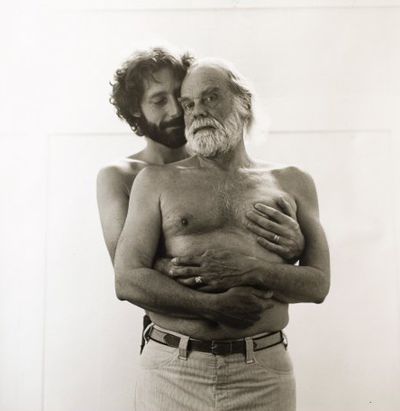 It’s probably obvious why we include Gay History as one of our Big Joy themes. If you see our film you know that James Broughton lived through some pretty spectacularly diverse eras in terms of queer acceptability. He lived through the McCarthy era where even the suspicion of homosexuality could cost you your livelihood.
It’s probably obvious why we include Gay History as one of our Big Joy themes. If you see our film you know that James Broughton lived through some pretty spectacularly diverse eras in terms of queer acceptability. He lived through the McCarthy era where even the suspicion of homosexuality could cost you your livelihood.
Like many gay artists, during that time (and prior) his work was often subjected to heavy self censorship. Back then, being gay wasn’t something you mentioned in public.
But his story is also personal. It deals with real struggles many face when they are queer. In Broughton’s lifetime he went from feeling like his effeminate nature was a flaw in need of fixing, to accepting it wildly, openly, and happily, without question. As a youth, he was kicked out of boarding school for gay activities but later went on to become the Grand Marshall of the San Francisco Pride Parade.
His story is a wonderful example of not only the rollercoaster ride of society’s acceptance of queer sensibility but also, the internal struggle when your sexual preferences do not coincide with the majority or mainstream. In his personal life, for a time, Broughton felt and succumbed to societal pressure to lead an outwardly heterosexual lifestyle.
Then, in his 60’s, he met his soulmate Joel Singer, and everything changed. He got married to Joel (before that was even a thing). He went on to produce many vibrantly gay works, (the poem “Nipples and Cocks” comes to mind, and the book Androgyne Journal and Graffiti for the Johns of Heaven) and lived his life as an openly gay and joyful human being. As author and Broughton friend Mark Thompson put it:
“James Broughton wasn’t wearing a gay liberation flag, he didn’t need to do that. He was embodying it, he was living it.”
James’ journey is inspiring and personal. It’s a bold and outloud depiction of the journey of queer acceptance in the US. It’s the story of a queer elder, which, due to history’s constraints and biases, is a perspective not often seen in today’s culture.
Broughton works especially highlighting this theme: Androgyne Journal, Graffiti For the Johns of Heaven
Here is a four minute video of James’ journey and Gay History.
Check our Pinterest page for snippets related to Broughton and Gay History.
Click on a word to see more about that theme.
BIG JOY THEME: CREATIVITY
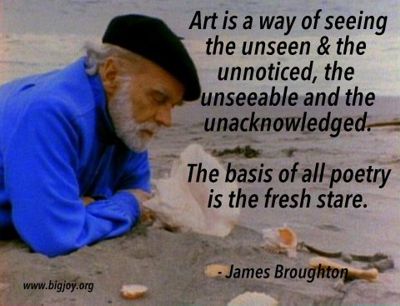 James Broughton lived a creative life for over 85 years. From his 23 films, his 23 books and his various writings on teaching, filmmaking and spirituality, James imbued his life with creative fervor.
James Broughton lived a creative life for over 85 years. From his 23 films, his 23 books and his various writings on teaching, filmmaking and spirituality, James imbued his life with creative fervor.
Author and Broughton friend Mark Thompson said, “James did the work. He was a dedicated artist. He wasn’t one of those, ‘Boo hoo! I have to suffer to make my art’ people. He got up and did it. He always had a work room, and it was filled with papers, bits of film, canisters of film, maybe a moviola, boxes of published books. But I remember one thing, above it all, wherever he and Joel moved, he would have this little banner that was calligraphed that said, ‘When in doubt, cut.’ Simple as it is, it was a great lesson in making art or making a life!”
James has lots of advice like this. You can find it especially in his book, Making Light of It, which Producer/Co-Director Stephen Silha describes as a book on living a creative and poetic life disguised as a text on filmmaking. It’s full of long and short advice on the creative process, such as his “Mottos for Editing Rooms.”
He was a master at creativity. To say that it oozed from his bones would also probably be accurate, but even more importantly it was because he lived it. Almost every day.
He wrote in his journal, those writings turned into poems, or sometimes films. For example his famous film, “The Bed,” started out as a list of words he jotted on a page and flowed from there to the images on the screen that you can still see today.
One of the primary staples of Broughton’s creativity was that creation and art are not separate from regular life. For him the two were meshed. Dancer/Choreographer Anna Halprin describes the time period in her and James’ lives (in the mid-late 1940s) when this concept was just emerging in the work that she, Broughton, and others were doing:
“Everyone was experimenting and exploring and trying out new ideas. We were just part of that movement. Because we [on the West Coast] were so separate from the East Coast where the arts are more commercialized, we were not bogged down by the intellectual, conceptual version of art. Once the conventional boundaries were broken through, then all of the new possibilities began to emerge. For example, [we realized] there is no given space that art must take place [like for example, on a stage]. We broke the boundaries by being able to incorporate … the connection between your life and your art. It was much more sensorial, open-ended, and connected to real life issues.”
Broughton, depending on his medium, used a combination of precision and collaboration in his creative processes. In his poetry he liked to find the perfect word; he would work at a piece until it was just right, exacting the meaning and the meter. In his films he liked to discover– to start with an idea and allow it to emerge from behind the camera.
Behind the lens he allowed others to feel it and make their own interpretations of his ideas through movement. Dancer/Choreographer Anna Halprin tells great stories about their filming collaborations, like in the film “Four in the Afternoon,” where she improvised to the poem ‘Princess Printemps.’ He just let her do what came to her.
Today, Broughton’s work is still inspiring creativity and other’s creative processes. Something that he would love. Inspiring or encouraging other’s creative process was something he liked to do even while he was alive. Tom Spanbauer tells a moving story of James’ celebrated and encouraged his work early on in his writing career. We’ve seen dance, films, DJ music tracks, and performance art that are all based on or inspired by Broughton’s work. In essence people are still working collaboratively with James through the words and images he left behind. We love hearing about this kind of thing. And we like sharing it too, so please drop us a line if you create something that was inspired by the work of James Broughton.
Broughton works especially highlighting this theme: Seeing the Light, and the later revised Making Light of It.
Click on a word to see more about that theme.
BIG JOY THEME: CELEBRATION
“I believe in ecstasy for everyone,” said James.
Broughton lived these words. In both his life and art he playfully explored ways to celebrate all kinds of living. In the words of author Armistead Maupin, “James let himself play and be goofy. In doing so he found his way to rather profound truths about what it is to be human.”
BIG JOY was, after all, his nickname later in life. Celebration was his way of being in the world. In fact James’ last words were “More bubbly please.” For Broughton, even leaving the earth held an element of festivity.
 In one of his poems aptly titled “An Appetite for Bliss”, he wrote, “My appetite for bliss keeps me going. Though I may never sample the Great Delight I am glad to know it is still on the menu.”
In one of his poems aptly titled “An Appetite for Bliss”, he wrote, “My appetite for bliss keeps me going. Though I may never sample the Great Delight I am glad to know it is still on the menu.”
He had a knack for it, as his friend and author, Mark Thompson said, “James was the life of every big party and he was a marvelous host.”
Even his autobiography, Coming Unbuttoned, is described this way by author Andrew Harvey: “Connoisseurs of the almost lost art of celebration will delight in James Broughton’s marvelous pithy witty wicked autobiography and find in it a feast of joy and wisdom.” It imbued almost everything he did.
We celebrate Broughton’s fiercely spirited commitment to his famous mantra; Follow your own weird and the way he inspired all of us to live with pizazz, or at least not to be embarrassed trying. He said,
Be wise and go merry round
whatever you cherish
what you love to enjoy what you live to exert
And when the high spirits
call your number up
count on merriment all the way to the countdown
Long live hilarity euphoria and flumadiddle
Long live gaiety
for all the laity
Broughton works especially highlighting this theme: Seeing the Light, and the later revised Making Light of It.
Click on a word to see more about that theme.
BIG JOY THEME: HEALTHY SEXUALITY
 James Broughton wasn’t shy about sexuality; in fact he lauded it. He wasn’t afraid to show naked people in his films (The Bed, Golden Positions, Erogeny, Hermes Bird, Devotions) or talk about them in his poetry. In fact he concluded one poem with these lines, “Don’t expect me to be sensible. I want everyone to be seduceable.” It was a part of who he was, but not a sleazy, dirty, let’s-leave-this-behind-closed-doors part. It was an active, out loud, and look-at-this-it-is-beautiful part. He was openly in love with the naked body and the sensuous experience of being human. He expected sensuality out of life. His words and films depict it as poetic. He celebrated it. He elevated it. He saw it as divine.
James Broughton wasn’t shy about sexuality; in fact he lauded it. He wasn’t afraid to show naked people in his films (The Bed, Golden Positions, Erogeny, Hermes Bird, Devotions) or talk about them in his poetry. In fact he concluded one poem with these lines, “Don’t expect me to be sensible. I want everyone to be seduceable.” It was a part of who he was, but not a sleazy, dirty, let’s-leave-this-behind-closed-doors part. It was an active, out loud, and look-at-this-it-is-beautiful part. He was openly in love with the naked body and the sensuous experience of being human. He expected sensuality out of life. His words and films depict it as poetic. He celebrated it. He elevated it. He saw it as divine.
Author Armistead Maupin said, “He seemed to say that your spiritual side and your sexual side are not only not conflicted with each other, they are one and the same.”
Poet Jim Cory, who edited Broughton’s last collection, Packing Up for Paradise, said, “Because of his preoccupation with love and its relation to the soul, I think of James Broughton as not so much as an erotic poet as a Romantic one. I mean Romantic in the best sense of that term, that is, in the sense that the work arises out of ardor, out of deepest romance. He espouses a point of view which sees the desire for sex and the desire for spiritual fulfillment as identical rather than opposite.”
We think that’s unusual. We think it’s beautiful. We’ve published a post called “A Sex Positive Culture According to James Broughton.” It’s eight axioms that we find in Broughton’s life, film, writing, and poetry that paint a more renewed, healthy, and vibrant picture of sexuality than the one that is typically offered on the subject. (Wham, bam, thank you mam…or sir.) It’s not sex or sexuality as an object, it’s sex and sexuality as a sensuous elevated journey.
Broughton works especially highlighting this theme: Ecstasies, Graffiti for the Johns of Heaven.
Click on a word to see more about that theme.
BIG JOY THEME: SPIRITUALITY
James Broughton had a pulsing connection to spirituality that thrummed through his life and work. His relationship with Spirit was an open dialogue. It wasn’t hidden or kept for special occasions or special places. It was woven into his day-to-day moving and meanderings, wherever he happened to be.
The way James looked at it, Spirit wasn’t something unknown. It might have been mysterious, but it was a regular visitor and something he actively called in and on. He did that through his journal, daily meditations and prayers, his poetry, his films, his friendships, his party throwing, his movement in this world. He was always on the lookout for it, and you might say from James’ perspective, Spirit was always on the lookout for him too!
James considered this human experience a playground for the divine. One could feel it, participate in it, and actively seek it. In fact he believed that man himself is divine and that we can experience this divinity even through this human experience. He wrote,
CANTICLE
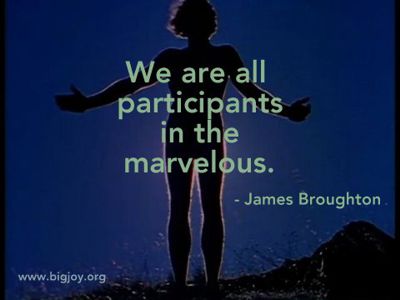 Open your doors Open my windows
Open your doors Open my windows
I dwell in you and you dwell in me
We are a duplex of comradely miracles
We are a house as large as mankind
Those we have sat lovingly beside
those we have ached for or laughed with
all those who have pierced us with joy
become residents of our habitation
Who needs to have it explained?
Who needs to have it defended?
This is an alleluia of life
This is our humming of humansong
James was raised Episcopalian, so he read the King James Bible (the language of which can be seen in his films and poetry, The Golden Positions, for example. Then he got into Zen and Buddhism. He often mentions the Tao. He added to and developed his own spirituality using mythological creatures and archetypes, such as his angel Hermes, Pan, Egyptian Mythology, feathers, and the tarot.
He viewed various Gods and Goddesses more as friends with specific divine qualities than symbols of idolatry. He worshiped whomever and whatever he felt a kinship with. He was Pantheistic. He and Joel created altars all over the house to these divine friends. His altars acknowledged them, prayed to them, and also invited them to help him connect to Spirit.
He wrote,
My penpals are unlettered demons and saints
I deal in romancement I ecstasize man
Love is my warrior to slay the Giant Sloth
My particular sidekicks are Pan and Jesus
who are working out a world-wind pas-de-deux
We often sit laughing by old Lao-Tzu’s river
My true-born parents are Hermes and Aphrodite
who gave me a new life where both ends meet
All I have to declare is the jewel in my lotus
*
His poem entitled, “Confession” probably sums it up best.
CONFESSION
Even if I never arrive
I shall keep departing
I believe in the unreachable
The unlikely and the unmentionable
Moses never got there
Jesus never got there
Buddha went there but he came back
Lao-Tzu simple packed up and left
Anywhere that I await
My traveler’s alert
I rely upon the dimensionless
The immediate and the imperishable
Imagination is
my praise of truth
The beauty of man
Is my hope and my sorrow
Wherever I may be landing
or hoping for takeoff
I swear by affection
exuberance and clarity
Broughton works especially highlighting this theme: Packing Up For Paradise
Click on a word to see more about that theme.
BIG JOY THEME: DEATH
James Broughton did death differently than most folks. To hear Joel Singer tell of it, it was magical really. But more than the actualities of Broughton’s dramatic and poetic exit, even the way that he lived with death and its eventuality was unique.
First of all, he held a funeral parade for himself 27 years before he died. He was teaching a class on ritual at San Francisco State. When he was invited to give a talk at the dedication of a new library in his home town of Modesto, he and his students staged a funeral parade for himself, ending on the graves of his ancestors.
Broughton wrote poems about death for a good 20 years before he died. His last anthology, Packing Up For Paradise includes a section, “On the Way to the Exit,” where he ruminates on death.
He was doing this as a man, advanced in years, but more or less a person like any other. He wasn’t faced with a life threatening illness or disease. He just knew (like we all do) that bodily death is an inevitable part of life. And he chose to be conscious about it. He thought about it. He paused and considered it. He wrote poetry about it. He questioned it and clarified what his relationship to this final act meant to him. He wrote,
OPEN TO QUESTION
In a cool neck of the woods
a long walk from the village
I hide out from grunge and glitz
and pray for a tidy apocalypse.
Nothing much on my mind but
Love, God, and Hereafter.
Though time is closing down
my life is still open to
whatever comes next
or whatever comes last.
With a shortening longevity
I need to consider last resorts.
A houseboat on the Styx?
A villa in Elysium?
A bedroll in the Void?
The forest darkens around me.
Where is my inevitable home?
Is that the ultimate surprise?
That was written in 1996. The day he died (May 17, 1999) he carried a snakeskin around with him all day to remind himself that he was just “shedding a skin.” And he recited his poem, “This Is It #2” a lot.
As Joel Singer, James’ husband and soulmate, said, “He thought of his death as a shedding of a skin, a merging with the Beloved, the Divine.”
He continues, “I remember when he actually took his last breath and when I felt his spirit just whooshing out the window. (All three of us that were with him felt it.) It was a great release. He just soared, at least that was my feeling.
“[We were listening to] one of James’ favorite pieces of music: La Koro Sutro by his friend Lou Harrison. It’s this gorgeous, glorious chorus that ends, “Gaté, Gaté, beyond, beyond,” in this crashing of cymbals and very exciting music. And James took his last breath, just at that last moment when the music reaches its peak.
They say that hearing is the last of the senses to leave us, so I’m convinced that he knew, he heard, and it was time. It just couldn’t have been more theatrical, in a sense. It was fantastic. We had the music on very loud; it just filled the house. The house was like a cathedral– it really felt like that. It was the ultimate of poetic.”
To hear more of the details of James’ poetic death, watch this video where Joel Singer tells the whole story.
How do you die a good death? According to James Broughton’s formula, you are conscious about it beforehand. You take time to think on it, and to see what it means to you. You take care of your earthly business. (He even sent off his last box of things to Kent State University, which houses his archives.) You make sure your will and all of that is intact. That you’ve communicated what you need. You prepare for the transition – among others James’ method included his snakeskin and the recitation of poetry. Because as James wrote, “This is It / This is really It / This is all there is / And It’s perfect as It is.”
Broughton works especially highlighting this theme: Packing Up For Paradise
